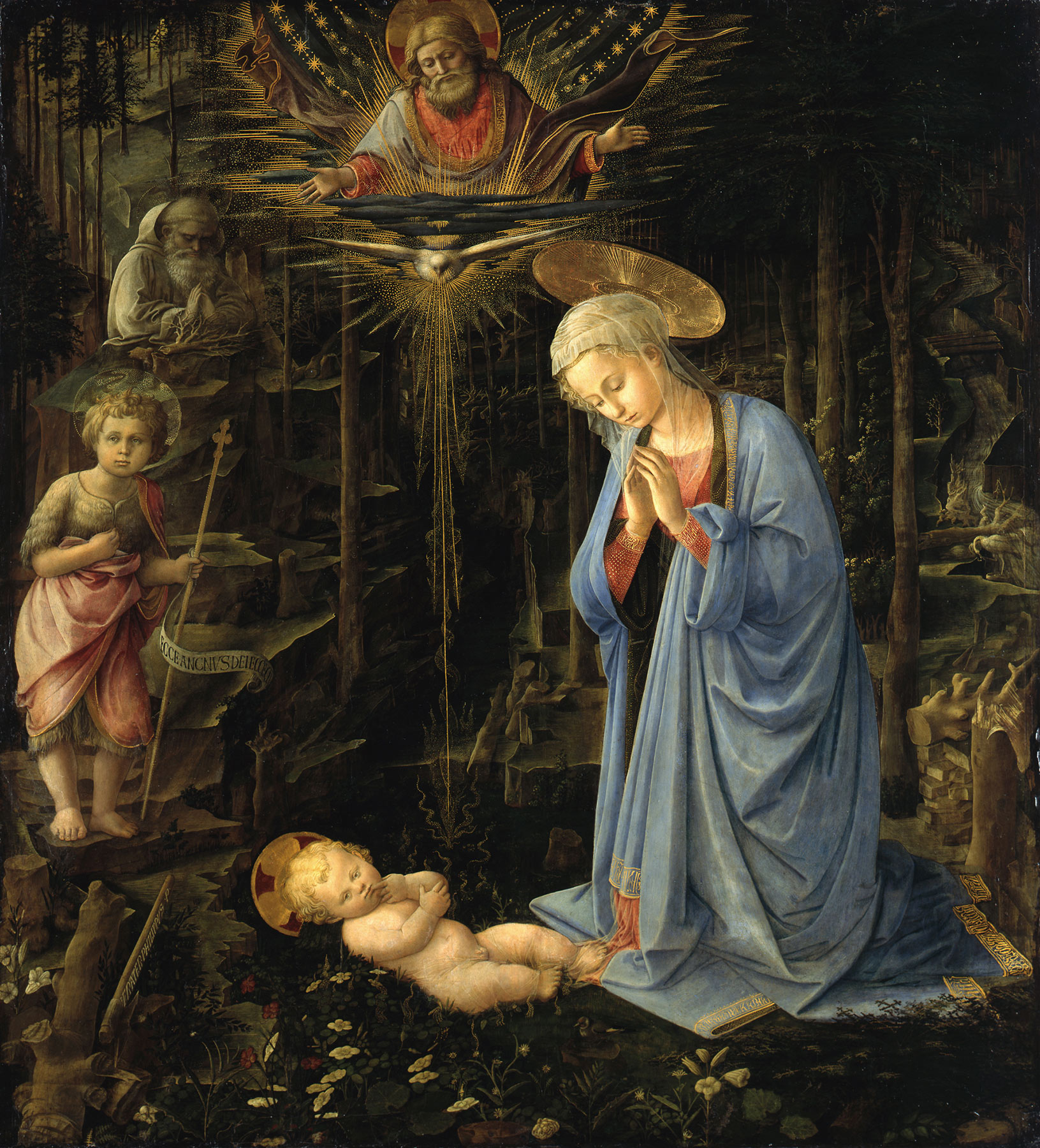Unknown
The frame and picture moldings are all affixed to a backing board with a vertical wood grain measuring approximately 89 by 51 centimeters and retaining its original thickness of 2.6 centimeters, which provides the support for the painted surface as well. A seam approximately 12 centimeters from the left edge of this board is open along its full length, dividing the picture field into two fragments. The frame moldings are preserved in their entirety but have been scraped down to the carved wood layers. The gold in the picture field is well preserved, as are some areas of the paint surface, especially the white draperies. The blacks are badly consumed, and flesh tones vary from well preserved to severely abraded. The blonde hair of all three figures is original.
The history of this painting before it arrived at Yale is unknown. It was discovered in 1943 during the registration of works of art in the bequest of Maitland Griggs and assumed to have been part of his estate, but it was unaccompanied by any paperwork relating to its having been part of his collection. Charles Seymour, Jr., confirmed that it belonged to Griggs, but he did not include it in his 1970 catalogue Early Italian Paintings in the Yale University Art Gallery, and it is not listed in Burton Fredericksen and Federico Zeri’s Census of Pre-Nineteenth-Century Italian Paintings in North American Public Collections.1 It was assigned its current accession number retroactively but was never given a credit line.
The composition is a reduction of the most frequently encountered group among all the paintings associated with the Pseudo-Pier Francesco Fiorentino.2 The three figures are each truncated versions of their counterparts in the altarpiece painted by Filippo Lippi for the chapel of the Medici Palace in Florence, now in the Gemäldegalerie, Staatliche Museen zu Berlin (fig. 1). Megan Holmes counted 44 paintings of this type among the 167 works that she studied by the Pseudo-Pier Francesco Fiorentino;3 Christopher Daly’s more recent list of attributed works numbers 220 separate entries but does not identify or enumerate the sources they reproduce.4 The copies range from a full-scale replica of the complete altarpiece (now installed in the Palazzo Medici, Florence) to reductions of various sizes, formats (including tondi), and numbers of figures, sometimes adding figures borrowed from other sources. The Yale painting is unique among the group in its inclusion of a peeled pomegranate, a symbol of the Resurrection, at the feet of the Christ Child.

The apparent range in dates for the many examples of this composition is wider than that for any other composition emerging from this studio, presumably beginning almost concurrently with Lippi’s original, around 1460, and possibly continuing until nearly the end of the fifteenth century. There is, in practice, no means of dating individual examples with confidence, but the Yale painting seems to fit comfortably near the middle of the sequence of these images. A date close to 1470 is a reasonable approximation. The frame in which the Yale painting is contained is original but has been stripped of any original gilt or painted surfaces. —LK
Published References
Holmes, Megan. “Copying Practices and Marketing Strategies in a Fifteenth-Century Florentine Painter’s Workshop.” In Artistic Exchange and Cultural Translation in the Italian Renaissance City, ed. Stephen Campbell and Stephen Milner, 38–74. Cambridge: Cambridge University Press, 2004. , 52, 55–56, 69n44, figs. 19–20; Christopher Daly, in De Marchi, Andrea, and Davide Civettini, eds. Pseudo Pier Francesco Fiorentino: Cristo di dolori. Florence: Enrico Frascione antiquario, 2022. , 44
Notes
-
Seymour, Charles, Jr. Early Italian Paintings in the Yale University Art Gallery. New Haven: Yale University Art Gallery, 1970.; and Fredericksen, Burton B., and Federico Zeri. Census of Pre-Nineteenth-Century Italian Paintings in North American Public Collections. Cambridge, Mass.: Harvard University Press, 1972.. ↩︎
-
For more on this artist, see the following entries: Pseudo-Pier Francesco Fiorentino, Virgin and Child with Two Angels; Pseudo-Pier Francesco Fiorentino and Desiderio da Settignano, Virgin and Child; Pseudo-Pier Francesco Fiorentino, Virgin and Child with Saint Catherine and Four Angels; and Pseudo-Pier Francesco Fiorentino, Virgin and Child with Three Angels. ↩︎
-
Holmes, Megan. “Copying Practices and Marketing Strategies in a Fifteenth-Century Florentine Painter’s Workshop.” In Artistic Exchange and Cultural Translation in the Italian Renaissance City, ed. Stephen Campbell and Stephen Milner, 38–74. Cambridge: Cambridge University Press, 2004. . ↩︎
-
Christopher Daly, in De Marchi, Andrea, and Davide Civettini, eds. Pseudo Pier Francesco Fiorentino: Cristo di dolori. Florence: Enrico Frascione antiquario, 2022. . ↩︎